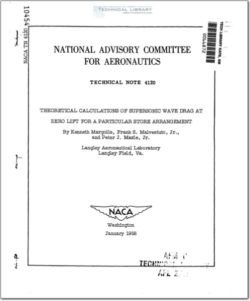NACA-TN-4120

- Version
- 132 Downloads
- 1.32 MB File Size
- 1 File Count
- December 4, 2015 Create Date
- December 4, 2015 Last Updated
National Advisory Committee for Aeronautics, Technical Notes - Theoretical Calculations of Supersonic Wave Drag at Zero Lift for a Particular Store Arrangement

An analysis, based on the linearized thin—airfoil theory for super-
sonic speeds, of the wave drag at zero lift has been carried out for a
simple two—body arrangement consisting of two wedgelike surfaces, each
with a rhombic lateral cross section and emanating from a common apex.
Such an arrangement could be used as two stores, either embedded within
or mounted below a wing, or as auxiliary bodies wherein the upper halves
could be used as stores and the lower halves for bomb or missile purposes.
The complete range of supersonic Mach numbers has been considered and it
was found that by orienting the axes of the bodies relative to each other
a given volume may be redistributed in a manner which enables the wave
drag to be reduced within the lower supersonic speed range (where the
leading edge is substantially subsonic). At the higher Mach numbers, the
wave drag is always increased. If, in addition to a constant volume, a
given maximum thickness-chord ratio is imposed, then canting the two sur-
faces results in higher wave drag at all Mach numbers. For purposes of
comparison, analogous drag calculations for the case of two parallel
winglike bodies with the same cross-sectional shapes as the canted con-
figuration have been included. Consideration is also given to the favor-
able (dragwise) interference pressures acting on the blunt bases of both
arrangements.
The magnitude of the supersonic wave drag of complete airplane con-
figurations is known to be dependent not only on the direct drag effects
generated by each component part of the configuration but also on the
indirect or interference effects introduced by each component on all
other components. For airplanes that require external fuel tanks, promi-
nent nacelles, or other auxiliary bodies for storage or bomb and missile
purposes, the location of such bodies relative to each other and to other
airplane components has been shown to be an important consideration from
the standpoint of obtaining low drag.
| File | Action |
|---|---|
| naca-tn-4120.pdf | Download |

Comment On This Post